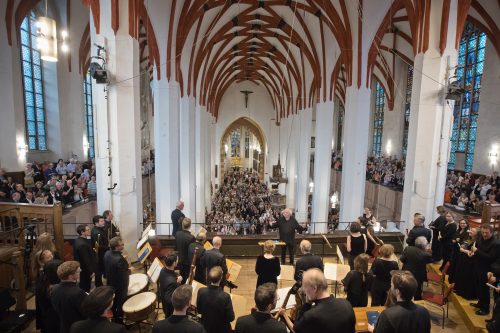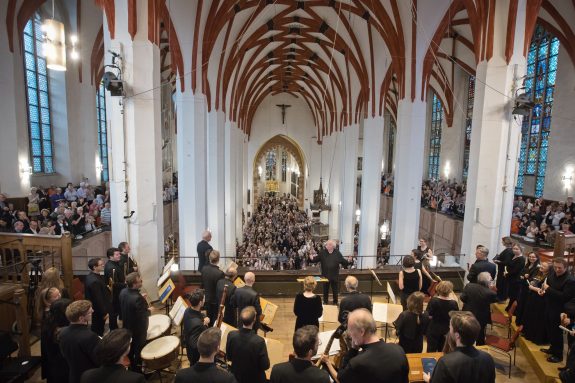 United Kingdom Bach, B minor Mass: Soloists, Collegium Vocale Gent / Philippe Herreweghe (conductor). Barbican Hall, London, 14.6.2024. (AK)
United Kingdom Bach, B minor Mass: Soloists, Collegium Vocale Gent / Philippe Herreweghe (conductor). Barbican Hall, London, 14.6.2024. (AK)

Dorothee Mields – soprano
Hana Blažiková – soprano
Alex Potter – countertenor
Guy Cutting – tenor
Johannes Kammler – baritone
We do not know why Bach composed this masterpiece, his B minor Mass, towards the end of his life. By religion Bach was Lutheran and he was in the employment of the Lutheran Thomaskirche in Leipzig. So why to set the words of the Roman Catholic Mass in an extensive musical composition which, owing to its length, would have been unlikely to be performed in any church service, let alone in the Lutheran establishment? Speculations for Bach’s reason are plentiful but, so far, none proved. But what is beyond doubt that Bach left us a grand choral-orchestral masterpiece with beautiful melodies, superb polyphonic treatment, and wide-ranging musical emotions to match (or perhaps even surpass) the words of the Mass.
The problem with Herreweghe’s otherwise admirable interpretation was the lack of the above-mentioned wide-ranging emotions. Perhaps Philippe Herreweghe was mindful of Bach’s Lutheran belonging (thus possibly favouring purity to excesses) but this is music written to words of the Roman Catholic Mass which is not afraid of emotions. Or perhaps the academic in Herreweghe was stronger than the sense of public communication. However, whichever way, with his writing for the three trumpets and timpani Bach clearly implied considerable heightened emotions.
Herreweghe conducted without a baton and with very small arm movements. The mode and mood were gentle throughout. The polyphonic lines were transparent, subdued dynamics were carefully constructed, and Herreweghe’s tempi beautifully matched words and music. However, for the ‘Et resurrexit’ and ‘Sanctus Dominus Deus’ choral numbers I would have liked unreserved jubilation, and for the ‘Osanna in excelsis’ chorus unreserved joy. It has to be said that the final chorus, ‘Dona nobis pacem’, was noble, truly expressive and radiant.
Herreweghe’s team are experienced and they read their conductor well. The two soprano soloists, Dorothee Mields and Hana Blažiková, set the mood beautifully with their duet in ‘Christie Eleison’: they know their music and each other well, furthermore they sang together in earlier Herreweghe Bach Mass performances.
The bass solos (‘Quoniam to solus Sanctus’ and ‘Et in Spiritum Sanctum’) were sang by baritone Johannes Kammler. Like all other soloists on stage, he delivered with beauty and professionalism. However, he is a baritone and I felt the lack of a designated bass singer in some of the bottom notes.
Tenor Guy Cutting delivered both of his solos, the ‘Domine Deus’ tenor-soprano duet as well as the Benedictus, with disciplined but decisively musical nobility.
The alto solos were presented by countertenor Alex Potter who gave his all throughout. His solos ‘Qui sedes’, the ‘Et in unum Dominum’ alto-soprano duet and, last but not least, the ‘Agnus Dei’ solo were beautiful beyond description. Potter did not break any baroque performance rules and respected Herreweghe’s subdued reading but still managed to reach the sublime.
All Herreweghe’s singers and players are disciplined professionals and true team workers. All five solo singers participated in the choral numbers (thus delivered by nineteen singers) and teamwork was palpable among instrumentalists too.
I was surprised to see the two cellists using spikes for their instruments while all else was pure baroque. I would have liked horn soloist Bart Cypers stand more exposed rather than in the middle of the orchestra: he delivered his important and tricky obligato solo in ‘Quoniam to solus Sanctus’ with admirable skills but slightly subdued owing to his placing within the orchestra.
Flute player Patrick Beuckels combined everything one can wish for: baroque style, intelligent phrasing, rhythmic adjustments (agogics, rubato within the bar) within adhering to the structure of music and words, and a variety of dynamics/ tonal colours. His obligato flute playing in the ‘Domine Deus’ soprano-tenor duet and, crucially, in the tenor’s ‘Benedictus’ raised the mood to a different level.
The concluding choral movement ‘Dona nobis pacem’ was as beautiful as meaningful. Politicians of the world should be made to listen to it.
Agnes Kory
